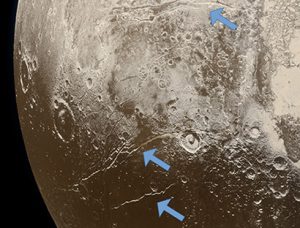
Researchers at University of California Santa Cruz (UCSC) wanted to understand how Pluto formed and managed to maintain a subsurface liquid ocean, despite being at the edge of the solar system, so they did some theory work and then went looking through the New Horizons data to find out what the data said was possible.
There were two schools of thought prior to today’s story. The first group said Pluto started out cold and by some unknown process, its internal ice melted. The other group said Pluto had a “hot start,” with oceans that later froze out. Conveniently, these two theories produce a Pluto that looks slightly different. The hot start theory requires evidence of expansion features on the surface, that would form as the ice expanded while freezing. An event that melts the oceans later would likely be associated with compression features, however.
Seeking to put an end to the “where did the oceans come from” debate, a team of researchers at UC Santa Cruz poured through the data and found clear evidence of a hot past. As first author and UCSC graduate student Carver Beirson explained: We see lots of evidence of expansion, but we don’t see any evidence of compression, so the observations are more consistent with Pluto starting with a liquid ocean.
Of course, these observations lead to a second question: where did Pluto get the energy for a “hot start”? The two main sources of planetary heat are radioactive decay and gravitational energy from the planetary formation. It’s unlikely that radioactive materials could generate as much energy as is needed, but a really fast formation could do the trick. Coauthor Frances Nimmo explained that “if [the gravitational energy] builds up fast enough the heat gets trapped inside.”
To contain enough heat to keep a liquid ocean, Pluto would have to have formed in under 30,000 years. Any slower, and heat would have time to radiate away to surrounding space instead of getting trapped inside Pluto. These findings could mean that large KBOs, such as Eris and Makemake, could also have similar icy oceans if they formed in a similar fashion.
Clearly, one flyby of one large KBO is not enough, and we are really hoping to someday get more data.
More Information
“Evidence for a hot start and early ocean formation on Pluto,” Carver J. Bierson, Francis Nimmo & S. Alan Stern, 2020 June 22, Nature Geoscience




 Join the Crew!
Join the Crew!
 Escape Velocity Space News
Escape Velocity Space News
0 Comments